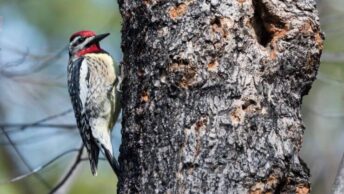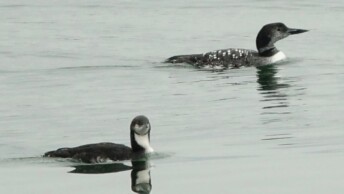Illinois is home to an impressive mix of birds that show up in backyards, city parks, and countryside fields throughout the year. Whether you’re in Chicago or out in the quiet stretches of farmland, you’re likely to spot familiar species going about their lives in every season. From the bright flash of a Northern Cardinal perched in a snowy bush to the gentle cooing of a Mourning Dove on a summer morning, these birds bring color and movement to everyday moments.
Some, like the American Goldfinch, transform from dull winter coats to brilliant yellows when warm weather returns. Others, like the Black-capped Chickadee, stick around all year, curious and unbothered by cold winds. In this article, we’ll take a closer look at some of Illinois’s most common birds and explore where you can find them, how to recognize them, and why they matter to the state’s landscapes.
1. Northern Cardinal
- Scientific name: Cardinalis cardinalis
- Life span: 3–15 years
- Size: 8.3-9.1 in (21-23 cm)
- Weight: 1.5-1.7 oz (42-48 g)
- Wingspan:.8-12.2 in (25-31 cm)
- IUCN Status: Least Concern
- State status: Breeding and common
- Migratory behaviour: Stays year-round; does not migrate.
The Northern Cardinal is a striking songbird found across the eastern and central United States, stretching into parts of Mexico. Males are known for their vivid red plumage and sharp black mask surrounding a sturdy orange bill. Females wear softer tan feathers with warm red accents on their wings and tails. Cardinals often perch in low shrubs or trees, where their clear, whistled songs can be heard echoing through neighbourhoods, parks, and forest edges year-round.
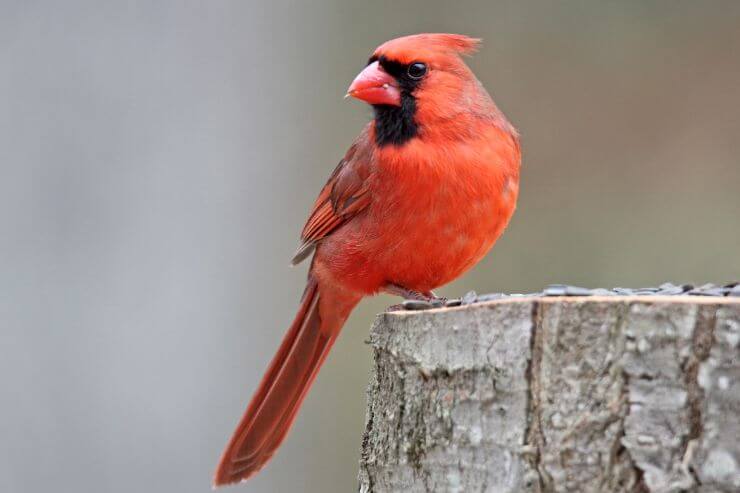
Cardinals build tidy cup nests hidden in shrubs or low trees. Females do most of the weaving, using twigs, bark, and grass lined with soft materials. Males guard nearby perches, singing boldly. Pairs often raise multiple broods each year, staying close to their chosen territories throughout the entire breeding season.
They eat seeds, berries, and insects, using their strong orange bills to crack sunflower seeds or pick fruit. During summer, they catch caterpillars and beetles to feed their nestlings. Cardinals frequently visit feeders, especially in winter, when natural food is scarce and they rely on backyard sources for extra energy.
Cardinal populations have expanded north over the past century, aided by suburban landscaping and winter feeders. They’re not considered threatened and have adapted easily to human-altered habitats. Because of their success, no special conservation actions are needed beyond preserving trees and shrubs where they can safely nest.
2. Blue Jay
- Scientific name: Cyanocitta cristata
- Life span: 7 years on average
- Size: 9–12 in (22–30 cm)
- Weight: 2.5–3.5 oz (70–100 g)
- Wingspan: 13–17 in (33–43 cm)
- Status: Least Concern
- State status: Breeding and common
- Migratory behaviour: Mostly resident; some migrate short distances.
Blue Jays are widespread across the eastern and central United States and southern Canada. They have brilliant blue backs and wings marked with black bars and white patches. Their pale underparts contrast with the bold facial pattern of a black necklace and crest.
The crest can be raised or lowered depending on mood. Blue Jays are easily recognized by their loud calls and confident movements, whether they are exploring treetops or visiting backyard feeders.
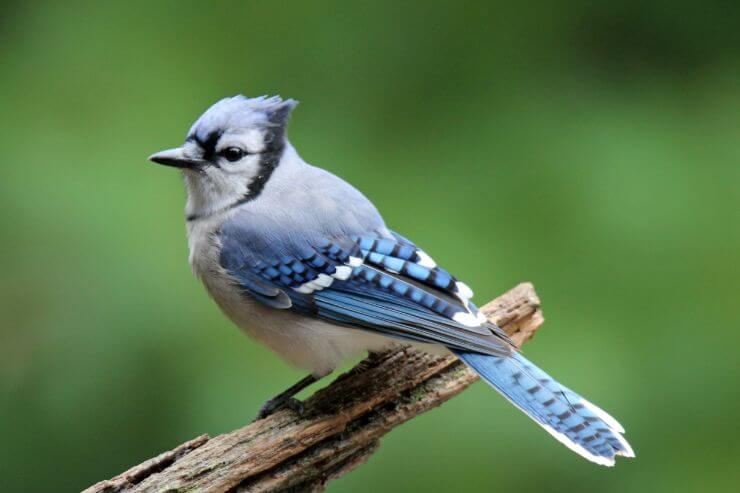
Blue Jays build nests high in trees, often on sturdy horizontal branches. Both sexes gather twigs, bark, and grass, shaping a well-built cup lined with softer materials. They fiercely defend their nests from predators and intruders, using loud calls and aggressive displays to protect their territory.
They eat a mix of acorns, nuts, seeds, and insects. Blue Jays also cache food in hidden spots, remembering locations later. Their habit of collecting and burying acorns helps oak forests regenerate naturally, making them surprisingly important to healthy woodland ecosystems.
Blue Jays are widespread and common throughout Illinois. Their populations have remained stable, and they adapt well to suburban neighbourhoods with mature trees. Because they are not threatened, conservation work mainly focuses on maintaining diverse forest habitats where they can thrive year-round.
3. American Robin
- Scientific name: Turdus migratorius
- Life span: 2-3 years
- Size: 9–11 in (23–28 cm)
- Weight: 2.7-3.0 oz (77-85g)
- Wingspan: 12–16 in (31–40 cm)
- Status: Least Concern
- State status: Migratory and common
- Migratory behaviour: Many leave in fall; some overwinter locally.
The American Robin is widely distributed across most of North America, from Alaska to Mexico. Recognizable by its warm orange breast, grayish back, and bold white throat markings, this bird often appears in yards and fields in early spring. In flight, white corners on the tail are visible. Robins have a confident posture and an alert gaze, and their rich, melodic song is one of the first signs that winter is giving way to warmer days.
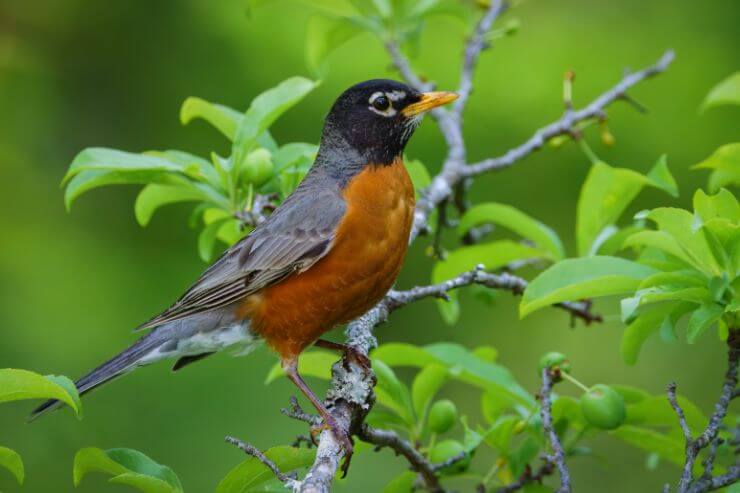
Robins build sturdy cup-shaped nests made of grass reinforced with mud. Females gather materials and shape the nest, often placing it on branches or ledges. They can raise two or three broods each season. Males help defend the territory, singing from high perches to announce their presence and discourage rivals.
They feed mainly on earthworms and insects, especially during the breeding season. In fall and winter, robins switch to berries like juniper and crabapple. You’ll often see them pulling worms from lawns or plucking fruit from trees, adapting easily as the seasons change.
Robins remain abundant across North America. Their flexible diet and tolerance for developed areas have helped populations stay strong. Although pesticides can reduce insect prey, overall numbers have held steady. They’re a welcome sign of spring returning to gardens, parks, and neighbourhoods throughout Illinois each year.
4. Mourning Dove
- Scientific name: Zenaida macroura
- Life span: 2–5 years
- Size: 9–13 in / 23–33 cm
- Weight: 4–6 oz / 112–170 g
- Wingspan: 17–18 in / 43–46 cm
- Status: Least Concern
- State status: Breeding and common
- Migratory behaviour: Some migrate south; many stay all winter.
The Mourning Dove is found all across the United States into southern Canada and Mexico. It has a smooth, pale gray-brown body with a long, tapered tail edged in white. Subtle black spots decorate the wings, and a delicate pinkish wash sometimes shows on the chest. Mourning Doves are often seen perched on wires or calmly walking across lawns. Their soft, mournful cooing is a familiar background sound in both urban and rural landscapes.

Mourning Doves build simple platform nests in trees, shrubs, or sometimes on sheltered ledges. Their nests are loosely woven from twigs and grass, often looking flimsy. Females lay two eggs, and both adults share incubation. Doves may raise several broods each year, reusing or repairing the same site when possible.
They feed mostly on seeds, gathering them by walking across open ground. Mourning Doves prefer grass seeds but also eat waste grain left in fields. They swallow seeds whole and store them in their crops before digesting them in a quiet, safe spot later in the day.
Dove populations have remained healthy despite hunting pressure and habitat changes. Their adaptability to farmland and suburban areas helps sustain strong numbers. Conservation measures focus on monitoring harvest levels and maintaining open areas where doves can feed and nest without disturbance from development.
5. European Starling
- Scientific name: Sturnus vulgaris
- Life span: 2-3 years
- Size: 7.5–9 in (19–23 cm)
- Weight: 2.1–3.4 oz (60–96 g)
- Wingspan: 12–17 in (31–44 cm)
- Status: Least Concern
- State status: Breeding and common
- Migratory behaviour: Year-round resident; some local movements occur.
European Starlings, also known as Common Starlings, were introduced to North America in the 19th century and are now widespread from coast to coast. Adults are glossy black with an iridescent sheen that flashes purple and green in sunlight. In winter, pale spots appear across their feathers, creating a speckled look. Their pointed yellow bills and triangular wings stand out when they fly in tight, swirling flocks. Starlings often gather in large groups around farms, city parks, and open fields.

Starlings nest in cavities, often taking over holes in trees, buildings, or nest boxes. They line the cavity with grass and feathers, packing in materials until the nest is level. Both parents help incubate eggs. Large flocks often nest in the same area, creating noisy, bustling colonies in spring.
They eat insects, fruits, and grains. Starlings probe lawns for grubs or beetles and flock to berry bushes when ripe. Their varied diet helps them thrive in farmland and urban settings. In winter, they gather in huge flocks, sweeping across fields to feed together.
Introduced to North America in the 1890s, starlings spread rapidly and now number in the millions. They can outcompete native cavity nesters, which has raised concerns. Although invasive, they are firmly established, and management focuses on limiting impacts rather than reducing overall numbers dramatically.
6. American Goldfinch
- Scientific name: Spinus tristis
- Life span: 3-6 years
- Size: 4.3–5.1 in (11–13 cm)
- Weight: 0.39–0.71 oz (11–20 g)
- Wingspan: 7.5–8.7 in (19–22 cm)
- Status: Least Concern
- State status: Migratory and common
- Migratory behaviour: Many migrate south in winter months.
The American Goldfinch ranges across most of North America, from southern Canada to Mexico, with many moving south in winter. Breeding males have brilliant yellow bodies, black wings marked with white bars, and a black cap on the head. Females and nonbreeding males are olive-brown above and duller below. These finches are often seen in flocks, flying in an undulating pattern over fields and meadows while calling with cheerful, clear notes.
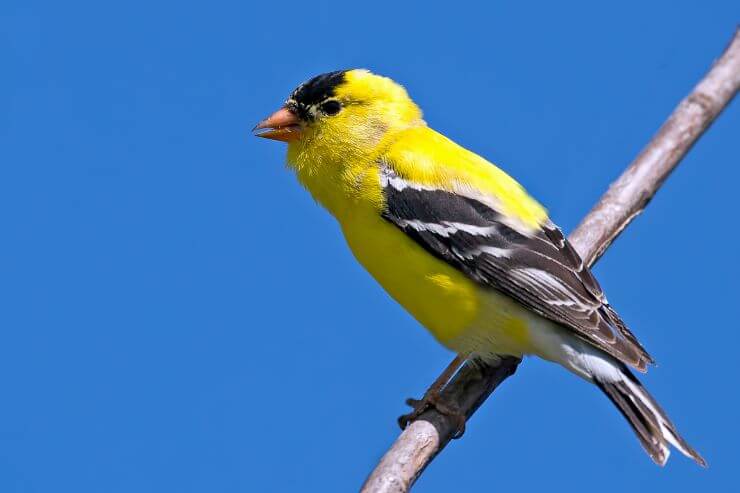
Goldfinches nest later than most songbirds, waiting for thistles and other plants to mature. Females weave tight cup nests lined with plant down, securing them carefully in shrubs or saplings. Males stay nearby, singing and guarding while the female incubates eggs during midsummer breeding.
They primarily eat seeds from sunflowers, thistles, and asters. Their specialized bills easily remove seeds from flower heads. Goldfinches also visit feeders stocked with nyjer seed, especially in winter, when natural sources become harder to find across open fields and gardens.
Goldfinch populations remain strong thanks to their adaptability. Suburban gardens, weedy fields, and preserved prairies all support them. Providing native plants and seed-rich habitats encourages healthy numbers. Because they are widespread and resilient, they have not required intensive conservation measures to remain abundant.
7. Red-winged Blackbird
- Scientific name: Agelaius phoeniceus
- Life span: 2-3 years
- Size: 6.7-9.1 in (17-23 cm)
- Weight: 1.1–2.7 oz (32–77 g)
- Wingspan: 12–16 in (30–40 cm)
- Status: Least Concern
- State status: Migratory and common
- Migratory behaviour: Most migrate south by late fall.
Red-winged Blackbirds are widespread throughout North America, especially common in wetlands and fields. Males are unmistakable, glossy black with bright red and yellow shoulder patches that they flash while singing. Females look very different, with streaky brown plumage that blends into cattails and grasses. Their loud, musical calls carry across marshes and roadside ditches. During migration, large flocks gather in fields and roost together, creating an energetic, shifting spectacle in early morning and late afternoon.
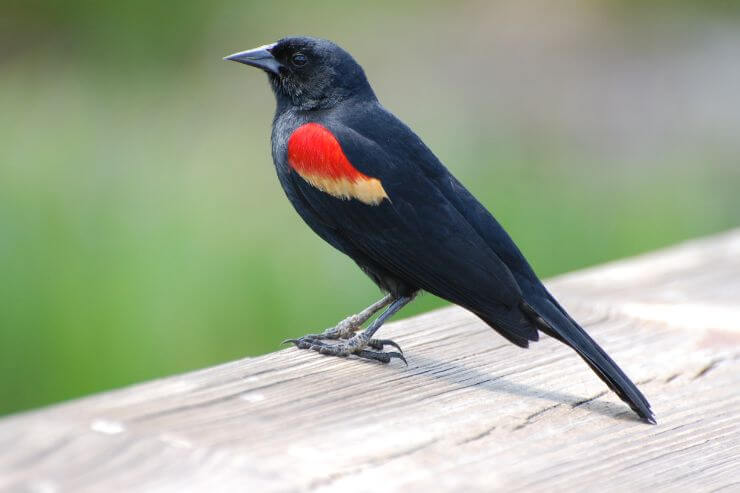
Red-winged Blackbirds build nests low among marsh plants or tall grasses. Females weave a sturdy cup attached to reeds or cattails, hidden from view. Males defend territories by singing and flashing their red shoulder patches. Pairs often raise more than one brood each season.
They eat insects during breeding and switch to seeds in fall. Red-winged Blackbirds forage in fields and wetlands, probing soil for prey or picking up grains. In winter, they form large flocks with other blackbirds, creating restless gatherings in open landscapes.
Though sometimes considered pests in agricultural areas, red-winged blackbirds remain abundant. Wetland preservation has helped maintain nesting sites. Because their numbers are strong, conservation measures focus mainly on habitat protection and understanding their role in farmland ecosystems.
8. House Sparrow
- Scientific name: Passer domesticus
- Life span: 3-5 years
- Size: 5.5-6.3 in (14-16 cm)
- Weight: 1.1-1.4 oz (30-40 g)
- Wingspan: 7.9-9.1 in (20-23 cm)
- Status: Least Concern
- State status: Breeding and common
- Migratory behaviour: Remains all year; does not migrate.
House Sparrows are small, adaptable birds that have established populations across cities and towns throughout North America. Males have gray crowns, chestnut-brown napes, and black bibs on their throats and upper chests. Females and young birds are plainer, showing warm brown backs and pale underparts with a soft stripe behind the eye.
These sparrows are often seen perched on fences, rooftops, or wires, where they gather in noisy groups near human activity all year.
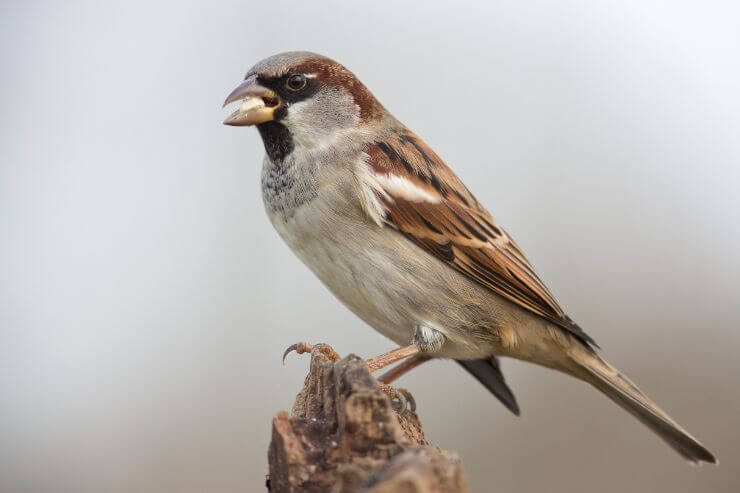
House Sparrows build messy nests tucked into cavities in buildings, eaves, or nest boxes. Both sexes gather grasses, feathers, and scraps to create a bulky structure. They often reuse the same sites year after year, forming loose colonies where many pairs nest close together in the same area.
They eat grains, seeds, and discarded food from sidewalks or patios. House Sparrows forage confidently near people, picking up crumbs and bits of bread. Insects also supplement their diet during breeding, providing protein to help chicks grow quickly in crowded urban environments.
Originally introduced from Europe in the 1800s, House Sparrows spread rapidly across the continent. They’ve become one of Illinois’s most familiar birds, thriving in cities and towns. Though common, their success has displaced some native cavity-nesting species. Their populations remain stable without needing conservation support or management.
9. Downy Woodpecker
- Scientific name: Dryobates pubescens
- Life span: 2-5 years
- Size: 6-7 inches (15-17.8 cm)
- Weight: 1 oz (28 g)
- Wingspan: 13 inches (33 cm)
- Status: Least concern
- State status: Breeding and common
- Migratory behaviour: Year-round resident across Illinois.
Downy Woodpeckers are the smallest woodpeckers in North America, found throughout forests, parks, and residential areas from Alaska to Florida. Their plumage is crisp black and white, with a bold white stripe down the back. Males have a small red patch on the back of the head, while females do not. Their short, chisel-shaped bills and delicate build help set them apart from larger woodpeckers. They often cling to tree trunks, tapping softly as they search bark crevices.
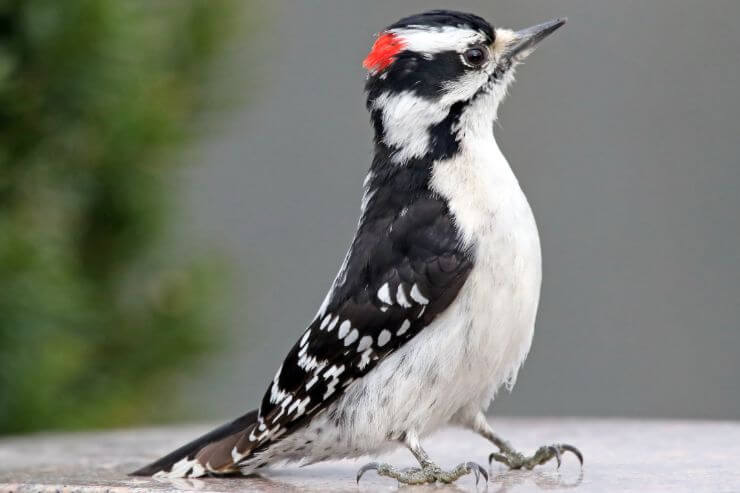
Downy Woodpeckers excavate nesting cavities in dead trees or branches. Both parents help chip away wood to form a deep chamber lined with wood chips. These cavities are used only once for nesting, though other species may later take shelter in the abandoned holes during winter.
They eat insects hidden beneath bark, especially beetle larvae and ants. Downy Woodpeckers also visit suet feeders and pick seeds from plant stems. Their steady tapping and careful searching make them a familiar sight along trunks and branches in wooded areas.
Downy Woodpecker populations are secure across Illinois. They benefit from parks and woodlots that maintain standing dead trees for nesting. Because they adapt to suburban areas and visit feeders, they remain among the most common woodpeckers without special conservation efforts.
10. Black-Capped Chickadee
- Scientific name: Poecile atricapillus
- Life span: Up to ~12 years
- Size: 4.7–5.9 in (12–15 cm)
- Weight: 0.3–0.5 oz (9–14 g)
- Wingspan: 6.3–8.3 in (16–21 cm)
- Status: Least concern
- State status: Breeding and common
- Migratory behaviour: Stays in Illinois throughout the year.
The Black-capped Chickadee is a small, lively bird found throughout the northern United States and much of Canada. It has a black cap and throat, clean white cheeks, and soft gray wings and back. Pale underparts give it a bright, tidy appearance. Chickadees often travel in small flocks, moving quickly among branches with short, fluttering flights. Their namesake “chick-a-dee-dee” calls and friendly curiosity make them a favourite in woodlands and backyard feeders alike.
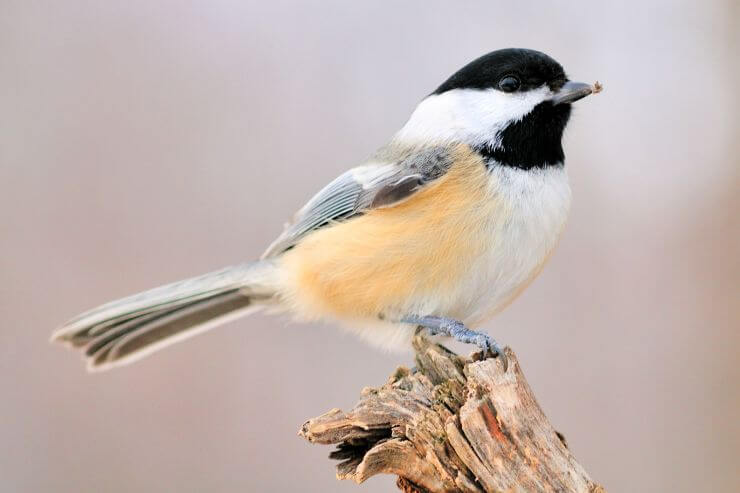
Chickadees nest in tree cavities, often excavating their own or using abandoned woodpecker holes. They line the chamber with soft materials like moss and animal hair. Both parents feed the chicks, making frequent trips back and forth as the young grow rapidly in their safe, hidden nest.
They eat insects, spiders, seeds, and suet. Chickadees often store food in crevices for later. Their quick movements and soft calls make them easy to recognize as they explore branches, always alert and curious while searching for hidden snacks in all seasons.
Black-capped Chickadees are widespread and secure across their range. They adapt well to woodlots and suburban yards. Nest boxes and winter feeders support their numbers. Because populations are strong, conservation efforts mainly involve maintaining natural habitats and encouraging people to plant native trees and shrubs.
Where to look for Common birds in Illinois
If you want to see Illinois’s most common birds, you don’t have to venture far. Even a short walk through a local park or your own neighborhood can turn up plenty of familiar species. Early mornings are often the best time, when birds are active and their songs carry across open spaces. Bring binoculars and take your time scanning trees, fences, and grassy edges. Look for movement among branches or flashes of color when a bird flits to a new perch.
A few spots stand out for great birding:
- Morton Arboretum in Lisle has miles of trails with chickadees, woodpeckers, and cardinals
- Montrose Point Bird Sanctuary in Chicago attracts migrating flocks as well as year-round residents
- In southern Illinois, Cache River State Natural Area combines wetlands and woods full of songbirds
- Rock Cut State Park near Rockford, where trails wind through mixed forest and open fields
Whether you’re watching a goldfinch perch on a thistle or hearing a jay’s sharp call, there’s something rewarding about getting to know these birds where they live. All it takes is curiosity and a little patience to discover just how much life fills Illinois’s landscapes.
Conclusion
Illinois’s common birds fill yards, parks, and fields with color and sound in every season. From the bright flash of a cardinal to the cheerful chatter of a chickadee, these familiar species bring nature close to home. Learning to recognize them makes time outdoors more rewarding. With a little observation and curiosity, you’ll discover how much beauty and life are waiting right outside your door, ready to be noticed.

